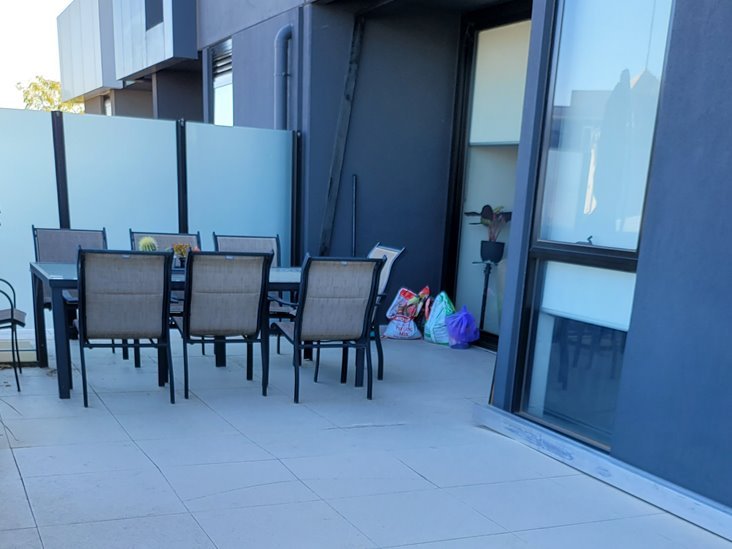BALCONY LEAK DETECTION
MELBOURNE
Call 1300 FINDLEAK For Balcony Leaks Melbourne Wide
Balcony leaks are a major problem in many homes and buildings, often going undetected or misdiagnosed for extended periods. It's important to note that only one in five balcony leaks are related to waterproofing issues. The most common sources of balcony leaks are windows and doors, cladding, and plumbing.
To effectively address and prevent balcony leaks, it's crucial to identify the correct source of the leak and take appropriate corrective actions. If you suspect a balcony leak, consult with professional leak detection service 1300 FINDLEAK to identify and resolve the underlying causes.
Why Does My Balcony Leak?
Understanding the Common Causes
Balconies are a delightful extension of our living spaces, offering a touch of the outdoors and a place to unwind. However, if you've ever experienced water seepage or noticed damp patches indoors right under your balcony, you know the stress of a leaking balcony. Here, we dive into the common reasons why balconies might leak and what you can do about it.
1. Improper Waterproofing:
One of the foremost causes of balcony leaks is inadequate or incorrectly applied waterproofing during the balcony's construction or renovation. This oversight can let water penetrate through the surface, risking damage to both the balcony and the underlying structures.
2. Cracks or Damage:
Simple cracks in the balcony's surface, walls, or even in the concrete can act as channels for water, especially during heavy rain or when the balcony has been exposed to moisture for an extended period.
3. Failed Seals and Joints:
Over time, sealants and joints around the balcony's perimeters, corners, and other connection points can deteriorate. When these fail, they can no longer keep water out effectively.
4. Poor Drainage:
Blocked or inadequate drainage systems on a balcony mean water doesn't have a clear path to exit. This stagnation can result in leaks and, over time, damage the balcony's surface.
5. Incorrect Gradient:
Water flows downward, and a balcony needs the right gradient to direct this flow away from the home. If the gradient is incorrect, it can cause water pooling, which is a prime suspect for leaks.
6. Substrate Movement:
Balconies aren't static; they can shift due to factors like temperature changes, settling of the building, or other natural causes. These movements can result in cracks or gaps that become entryways for water.
7. Wear and Tear:
Nature's elements, combined with regular foot traffic, can erode a balcony's protective layers over time. This wear can weaken its defenses against water.
8. Defective Membranes:
A balcony's waterproofing membrane is its shield against moisture. If this membrane is damaged or improperly installed, it's almost a direct invitation for leaks.
9. Lack of Maintenance:
Like everything, balconies require upkeep. Regularly inspecting for damages, ensuring joints are sealed, and drains are clear can make all the difference in leak prevention.
10. Inadequate Materials:
Opting for cheaper or low-quality materials might save money initially, but it often leads to quicker deterioration and potential leaks.
11. Impact from Debris:
Sometimes, external factors like falling branches or debris from nearby construction can damage the balcony, creating vulnerabilities where water can seep through.
Membrane Testing
Thermal Imaging
Plumbing Defects Testing
Construction & Component Defects
Compliance & Installation Requirements
In Conclusion:
If you're grappling with a leaky balcony, it's vital to address the issue promptly. Reach out to a professional contractor or a waterproofing expert who can guide you on the best course of action, ensuring your balcony remains a safe and enjoyable space for years to come.
HOW TO RECOGNISE A BALCONY LEAK?
Waterproofing
What are the testing methods?
Flood Testing: This method involves temporarily flooding the area with water to check for any signs of leakage. It is commonly used for large waterproofed areas such as basements, roofs, or concrete structures.
Electronic Field Vector Mapping (EFVM): EFVM employs electronic devices that can detect the presence of moisture or leaks in waterproofing membranes. It uses electric currents to identify breaches in the waterproofing system.
Infrared Thermography: This method uses thermal imaging cameras to detect temperature differences on the surface. By identifying areas where temperature variations occur, it can help locate potential leaks or areas of moisture infiltration.
Dye Testing: Dye testing involves injecting colored dyes into suspect areas to track the path of water flow. This method helps identify the source and route of leaks within the waterproofing system.
Pull-off Testing: Pull-off testing involves applying a force to the waterproofing system to assess its bond strength and adhesion. This method can determine the quality of the bond between the waterproofing membrane and the substrate.
Nuclear Moisture Testing: This method uses a nuclear moisture gauge to measure the moisture content in a material. It can be used to assess the moisture levels within the waterproofing system.
Pressure Testing: Pressure testing involves subjecting the waterproofing system to increased pressure to check for any leaks or weaknesses. This method is commonly used for pipes, tanks, and other pressurized systems.
What is the most effective method?
1. Flood Testing: Flood testing involves temporarily flooding the waterproofed area with water to assess its performance under real-world conditions. This test is particularly useful for large waterproofed areas such as roofs or basements. It allows for direct observation of any leakage or water infiltration and can help identify the source and extent of the problem. Flood testing provides a practical evaluation of the waterproofing system's integrity and is often considered a reliable test.
2. Electronic Field Vector Mapping (EFVM): EFVM utilizes electronic devices to detect leaks or breaches in waterproofing membranes. It involves the application of low-voltage electrical currents to the surface, which are then monitored for any disruptions caused by the presence of moisture. EFVM is a non-destructive and efficient method for locating leaks and can be especially useful for identifying hidden or hard-to-detect leaks in flat roofs or below-grade waterproofing systems.
What is Electronic Field Vector Mapping?
EFVM is a leak detection method used in waterproofing systems, particularly for detecting leaks in flat roofs and waterproof membranes. EFVM utilizes an electric current and a conductive grid to create a low-voltage electrical field on the surface of the roof or membrane. A conductive medium is applied to the surface, and any breaches or punctures in the waterproofing system allow the electrical current to flow through and create a detectable signal. This method allows for the accurate detection and precise mapping of leaks, making it an effective tool for identifying and repairing leaks in roofing and waterproofing systems.
What are the limitations of EFVM?
1. Limited to conductive surfaces: EFVM requires the presence of a conductive surface to create an electrical field. Therefore, it is not suitable for non-conductive materials such as certain types of roofing membranes or coatings.
2. External leaks only: EFVM is primarily designed to detect leaks on the external surface of the waterproofing system. It may not be as effective in identifying leaks originating from within the structure or concealed areas.
3. Inability to detect small or intermittent leaks: EFVM relies on the flow of electric current through breaches in the waterproofing system to create a detectable signal. Very small leaks or intermittent leaks that do not consistently allow the current to flow may go undetected.
4. Sensitivity to environmental conditions: External factors such as moisture, temperature, and humidity can affect the accuracy and reliability of EFVM results. Extreme weather conditions or the presence of standing water on the surface can interfere with the detection process.
5. Reliance on proper installation and setup: The effectiveness of EFVM depends on proper installation and calibration of the conductive grid, as well as the skill and experience of the operator. Errors or improper setup can lead to false positive or false negative results.
Find & Fix Your Leakage Today!
At 1300 FINDLEAK, our commitment to building enduring relationships with our valued customers is at the core of our philosophy. With a decade of extensive experience in gas and water leak detection across both residential and commercial environments, our expertise stands unrivaled in the field. Our reputation is further solidified by being trusted by over 200 industry-leading plumbing companies, builders, real estate agents, councils, water suppliers, and property maintenance firms. Our proficiency extends to locating a diverse range of building leaks, whether they are internal or external, encompassing roof leaks, balcony leaks, shower leaks, underground leaks, mysterious or intermittent leaks, and burst pipes for gas and water.
Our team of certified technicians at 1300 FINDLEAK boasts full licensing and insurance, ensuring the delivery of premium service. Armed with cutting-edge equipment including advanced thermal cameras, acoustic leak detection devices, tracer gas detection tools, CCTV camera inspections, moisture mapping technology, fluoro dye testing, roof assessment techniques, and precise Utility Line Locating methods, we steadfastly uphold our position at the forefront of technological advancements. Our unwavering commitment to innovation involves a continuous investment in the latest European tools, thereby allowing us to provide holistic water leak detection solutions across Melbourne. The hallmark of our service lies in its accuracy, efficiency, and the unwavering commitment to customer satisfaction.
Our pricing structure is fixed and determined based on the service required and the specific location, ensuring transparency and affordability. Embrace our services for a dependable and professional approach to identifying and resolving leaks.
Experience convenience by searching your post code for an instant quote. By selecting the leak detection category, you'll gain access to our live calendar, enabling you to effortlessly choose a suitable appointment time that aligns with your schedule.
Starting from $298 including GST for the first hour, with an additional charge of $98 for every extra hour. The final cost depends on your location. Most inspections only take one hour, but if additional time is needed, the technicians will inform you before proceeding. Book online or free call 1300 FINDLEAK (1300 346 353).
Family Owned & Operated
We're family-owned and run providing you with personalised service where the customer always comes first and is always right. When it comes to leak detection services, Melbourne can rely on us to care about your home and treat it like it is our own.
No more scary bills! We offer transparent and fixed prices for each job so you can rest easy knowing exactly how much you'll be paying. You can even book online or call us directly for a hassle-free experience.
At 1300 FINDLEAK, we are committed to providing our clients with reliable, professional, and affordable leak detection services in Melbourne.
Local Melbourne Balcony Leak Detector:
Seeking leak detection in Melbourne? We service a vast in Victoria including Mornington Peninsula, Werribee, Gippsland, Bendigo, Ballarat, and Shepparton. We also cover areas outside Victoria including Sydney, Wollongong, in Brisbane and the Gold Coast.
Ready for Hassle-Free Leak Detection?
Head to the "Book Online" tab or free call 1300 346 353 for more information. Schedule at your convenience, and let our experts handle the rest.
1300 FINDLEAK – Your Ultimate Shield Against Leaks in Melbourne!
1300 FINDLEAK is a national leak detection and repair service. We cater to a wide range of clients, including plumbing companies, property maintenance companies, real estate agents, councils, and water suppliers. We have experts who can fix any gas or water leak damage using their skills and knowledge. No job is too big or small, so call the leaders in gas, water and pool leak detection, residential or commercial today!
-

24/7 Emergency Service
-

Need a Leak Detector?
-

Have a Question?










